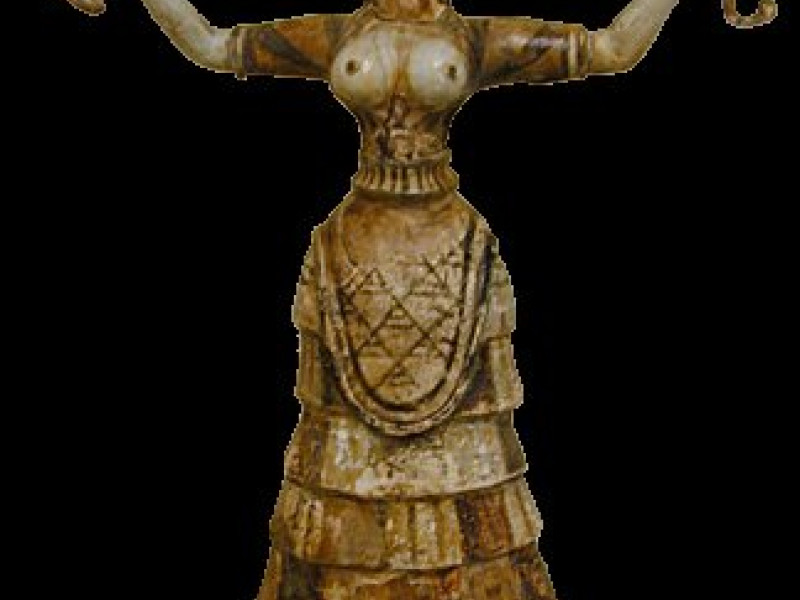Mother Goddesses
During the Neolithic period and the Bronze Age, the mother goddesses were very prominent in Crete, the Cyclades and on mainland Greece.
This page not only looks at Hellenic mother goddesses in Greek mythology, but also looks briefly at a couple of mother goddesses who were worshipped during the Bronze Age, where there are no extant literary accounts.
What Are Mother Goddesses?

What do we mean when we identify a female deity as a mother goddess?
Does mother mean in the sense, a mother who nurtured and protected the young? Was she a goddess of childbirth? Was she a creator goddess or an earth goddess (usually known as Earth Mother)? Does it mean that she was a fertility goddess or was she a goddess of nature?
What does it mean by "fertility"?
Mother goddess could mean fertility, but the term "fertility" is in itself rather vague, and could mean a number of different things. Fertility could mean the earth itself, eg. fertility of the land; or could be the growing of crops or other plant life. It could also mean fertility of the animals, as well as that of humans, by the means of mating or sexual intercourse. As you can see, fertility is not a good definition to use.
The mother goddess may also have had many different roles. The mother goddess could be distinguished from the Earth Mother (earth goddess), but sometimes the two were confused and their roles tended to blur, as it was the case with Gaea. Gaea was both an Earth Mother and a mother goddess.
The Earth Mother could be seen as the primal force and the source of all life. She did not necessarily have a maternal or nurturing nature.
The mother goddess was often a protectress of the young. Sometimes, the mother goddess was the mother of ruling tribe of gods, as was the case with Rhea being the mother of the Olympian deities.
See also Gaea and her Daughters.
The mother goddess was also seen with the divine consort of a mortal or even divine ruler, whom she had to periodically mate with, as was the case with Cybele and her consort Attis, so that the year's season was renewed.
The mother goddess might even have had more than one attribute, as was the case with Demeter, the goddess of corn. Demeter was also the mother goddess and goddess of fertility. See also Demeter and Persephone.
So far I have only mentioned goddesses what we know of through literature and mythology after the Dorian invasion. I have not mentioned the goddesses of the Bronze Age Aegean civilisations. Most of the authors we read set all mythological events before the arrival of the Dorians; thus in the Bronze Age.
However, the only writings about the deities in the Bronze Age mentioned their names on the Linear B tablets in Knossos and Pylos, and nothing else. There was no literature or mythology; there are no surviving details about their cultures, beliefs and their history. See Linear B on the Greek World page (Facts and Figures).
Only some of the names that appeared in these tablets survived in classical periods. The rest of the names were unrecognisable, or perhaps they were probably local deities.
In Pylos, there are Linear B tablets which mentioned the name, MA-TE-RE TE-I-JA, or Mater theia, which actually means "Mother Goddess". Who this goddess was, we can only guess.
Since the Linear B tablets provided very little understanding about any deities during the Bronze Age, we have to rely mostly on artwork that has survived.
However, none of these figures that appear in the artwork provide us with any names, so we can only rely on the interpretations of experts. But with many pieces of artwork, it is hard to determine if each female figure was portraying a goddess, a priestess or a female ruler.
Judging by the number of icons that have survived, there is a strong belief that the female deities were more predominant than the male deities. It is generally believed now that the goddesses they worshipped were mostly the mother goddesses.
Some experts believe that the Minoan and Mycenaean civilisations worshipped not a number of goddesses, but one, powerful goddess, just like the Israelites worshipped the One God. The worship of the Mother Goddess has existed as far back as the Neolithic period.
In Crete, the Minoan civilisation only worshipped goddesses, judging by the amount of art dedicated to them. Though the Linear B in the palace of Knossos showed the names of some gods such as Zeus, Poseidon and Ares, the dating of these writings showed that they were written after the Mycenaeans invaded and occupied Crete, around 1450 BC.
Until we one day decipher the Linear A texts, which was clearly invented by the Cretans, we will never know if the Minoans only worshipped goddesses or not, or if any male deities existed in the Minoan society.
With the arrival of the Dorians and other Hellenic-speaking tribes, they brought with them their own pantheon of deities where the gods were dominant, with Zeus ruling supreme over all.
We can only speculate how many pre-Hellenic goddesses survived the transition from Bronze Age to the Iron Age. The new people tried to either suppress the worship of the goddesses or to reduce their roles.
Related Pages
By Jimmy Joe











